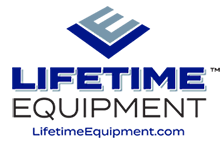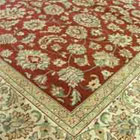The best way to keep these beautiful floor coverings clean is to simply prevent them from getting dirty to begin with. Oriental rugs (particularly small ones) should receive regular, thorough vacuuming on both sides to eliminate dirt, dust, and debris. Taking off shoes before walking on Oriental rugs is a good idea too.
Even with the best dirt-prevention efforts, however, Oriental rugs will eventually require periodic professional deep cleanings just like any other floor covering. Extreme care must be taken during cleanings to ensure colors don’t run and the delicate wool fibers aren’t damaged.
Jon-Don carries specialty chemicals and cleaning treatments specifically designed to clean Oriental rugs without causing colors to bleed or delicate fibers to fray. We highly recommend that periodic deep cleaning be only performed by professional carpet cleaners.
Cleaning Wool Rugs
Wool rugs are highly susceptible to bleeding. Test each color with each chemical for colorfastness. One color may not be a bleeder, but another color may.
Until recently, guidelines for cleaning wool have been very simple: keep the pH between 4.5-8.5 and you would be safe. These guidelines supposedly were created by Wools of New Zealand. Wools of New Zealand eventually abdicated their marketing position and the Wool-Safe Organization of Great Britain took over. Evidence showed that the pH guidelines previously used did not hold up to testing. Several products that were in the safe range caused color migration (bleeding) while some that were as high as 11.0 did not cause any problems.
The problem came from products that were buffered. Buffered solutions are used as a means of keeping pH at a nearly constant value in a wide variety of chemical applications. In other words, if you are cleaning a greasy restaurant, the product of choice will normally be a strong alkaline detergent (pH of 11.0-12.5) to break down the fatty acids in the grease. This detergent will be buffered to stay at the elevated pH range and not be neutralized by the high concentration of fatty acids in the grease.
On the other hand, if you are cleaning wool with an alkaline detergent, you want it to be non-buffered. This product will neutralize as it dries. The ideal pH range when finished cleaning wool is 4.5-5.5. This is the pH range at which the wool was dyed.
The safest way to choose a product is to look for the Wool Safe label which shows the picture of a sheep. There is no clear-cut way for the end-user to determine what the buffers are like in a detergent. An end-user must rely on the Wool Safe approval of the product.
Basic Method
Vacuum the rug three (3) times. Vacuum both the face and the backing fibers.
Carefully test for colorfastness on all colors with your properly diluted solutions, just as you should in regular cleaning.
Using a trigger sprayer on a mist setting, mist first with Matrix All Fiber Rinse diluted at 4-6 oz per gallon of water.
Using a shampoo machine, shampoo clean the rug with Chemspec Oriental Rug Shampoo diluted at 8 oz per gallon of water.
Using a Grandi-Groom, groom the pile downward with the nap.
Clean any white fringe by applying Chemspec Rx for Fringe diluted at 1/3 of a cup to 1 gallon of water. To this add 1 oz of a liquid detergent, such as Matrix Confidence Premium Extraction Detergent. Brush in an outward motion and on fringes only. Allow to dwell 3-5 minutes then rinse with a hand tool. Use minimal moisture to avoid browning.
Speed dry with air movers to avoid browning.
Immersion Rug Cleaning
As with all cleaning methods, dry soil removal must be done prior to overall cleaning. This can be done with a thorough vacuuming of the front and back of the rug. If the rug is a shag or Flokati style a suction only vacuum must be used. Additionally a portable duster or a compressed air duster can be used.
The rug should be tested for colorfastness using the most alkaline product that may be used. Keep in mind that alkalinity can cause bleeding. Be sure to allow the tested area to dry as bleeding may occur in the final stages of drying. To help prevent bleeding the use of Proschoice CSS can be beneficial.
Use a tested preconditioner such as Matrix Accomplish followed by agitation and adequate dwell time.
At this point an in-plant automated machine using Chemspec Double Strength InPlant or Chemspec Liquid InPlant followed by extraction or compression rolling, or centrifuge.
If in-plant equipment is not available you may create your own immersion cleaning tub with plastic and PVC pipe or an immersion tub. Extraction can be done with a wand, roller or sub-surface drying tool.
This also is an excellent way to treat urine contamination using Proschoice Rug Restorer.
As with any cleaning, rapid drying is facilitated by the use of air movers such as the Tempest. For multiple rugs a dehumidifier such as the Ultimate 340 LGR Dehumidifier can be used for rapid drying.
Warning: Always test materials for colorfastness, follow label directions, and never mix products unless specified in the label directions. Each situation reacts differently and results may vary.
How to Clean the Fringe on Rugs
The fringes on Oriental rugs often brown out and need to be cleaned. Care needs to be taken that no other parts of the rug are touched with these cleaning suggestions, as it may bleach out the color on the rug itself. Chlorine bleaching agents can dissolve wool or silk.
Basic Method:
In a bucket, combine equal parts of Matrix Target Tannin and warm water and apply to fringe.
Scrub area using a detail brush or sponge.
Rinse with water.
There are many different rug fringe types. Please call our highly trained and professionally certified team for specific instructions and product recommendations.





